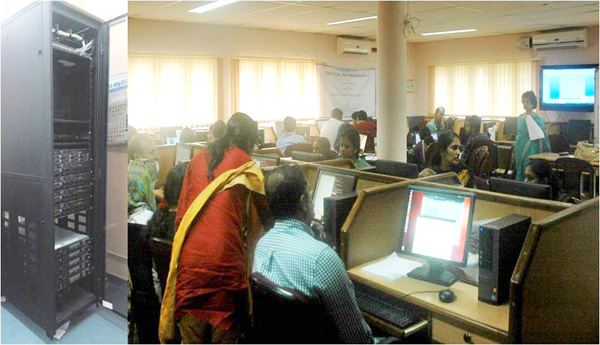Home
Research
Research Facility
CCF - Campus Computing Facility
Research Facilities
CCF - Campus Computing Facility
University of Kerala


The Campus Computing Facility is a dedicated Central Computing Facility under the DST Purse Programme, which enables faculty and students to use computational methods in their research. The Linux cluster at CCF is dedicated for the researchers to enable the next generation of computational scientists to make full use of this important technology. For easy access and better utilization of these facilities, a series of training programmes and workshop is being carried out on various aspects of scientific computing. CCF has 25 Desktop computers and a High performance computing cluster which has has 10 nodes: - a master node with 24GB of RAM and nine compute nodes with 8 GB RAM each. Each node is a dual six-core Intel®XeonE5645 series 2.40GHz rack server. The softwares installed in CCF for the utilization of researchers and faculties are as follows:
Chemistry related softwares
- Turbomole 6.4 for quantum chemical application
- NWChem 6.0 ab initio computational chemistry software
- Tinker 6.1 molecular modeling package for molecular mechanics and dynamics
- GROMACS (GROningen MAchine for Chemical Simulations) is a molecular dynamics package primarily designed for simulations of proteins, lipids and nucleic acids.
- VMD
Bio-informatics applications
- HMMER
- NCBI BLAST
- MpiBLAST
- Biopython
- ClustalW
- MrBayes
- T_Coffee
- Emboss
- Phylip
- Fasta
- Glimmer
- perl-bioperl
Parallel computing MPI libraries
- OpenMPI
- MPICH
Compilers
- C
- C++
- FORTRAN
- Perl
- Python 2.7 and ipython 0.10 interactive shell for python programming
Statistical Analysis
- IBM SPSS 20
- pspp 0.6.2
Remote Access and Virtual Desktop
- FreeNx for ssh based remote login
- OpenSSH
Statistical computing and Graphics
- R 2.15.2 for Statistical computing and Graphics
- 4.2.6 for 2D and 3D plots
- python–matplotlib 0.99 2D plotting library
Mathematical and Numerical Computation
- Blas 3.2 ,Atlas 3.8, GotoBlas2 ,Openblas linear algebra library
- Scilab 5.4.0 for numerical computation
- scipy 0.7.2 and numpy 1.4.1 mathematical and scientific computing library
- Matlab2012
Job Queueing system
- SGE 6.2 Sun Grid Engine (Open Grid Scheduler)
- Condor High Throughput Computing environment
Cluster monitoring system
- Ganglia
Web server
- Apache
Computing Facilities extended currently to the following Research Areas:
(i) Computational Chemistry
HPC facility is used mainly to run job using NWChem program. It has been used in connection with certain projects that have got biochemical significance. Density functional theory calculations were employed to quantify the effect of hydrogen bonding interactions in the nucleophilic exchange reactions involving cystines and selenocystines. The computed gas phase reaction mechanism involves hydrogen bond transfer from one heteroatom to another across the reaction coordinate along with the anionic charge transfer from the nucleophile to the product. Thus, the mechanism contains more than one intermediate and transition structure. The solution phase mechanism is simple S N 2 irrespective of the nature of the reaction centre or hydrogen bonding interaction at the reaction site, or the nucleophile. When compared to similar reactions without any hydrogen bonding interactions at the reaction center, these were found to be very facile both in gas phase as well as in aqueous solution.
(ii) Membrane dynamics
Modelling biological system behaviour is a significant task of systems biology and mathematical biology. Computing systems biology, aims to develop and use efficient algorithms, data structures, visualization and communication tools with the goal of computer modelling of biological systems. Currently the dynamical and configurational properties of lipid bilayer membrane is analysed computingly using molecular dynamics (MD) simulations which computingly prohibitive to carry out its long term behaviour. Ms Lekshmi Krishna M. R., a research scholar, is trying to develop more computingly affordable and efficient Brownian dynamics simulation schemes to obtain their properties.
(iii) Social Network Analysis
Social network analysis [SNA] is the mapping and measuring of relationships and flows between people, groups, organizations, computers, URLs, and other connected informa tion/knowledge entities. The nodes in the network are the people and groups while the links show relationships or flows between the nodes. SNA provides both a visual and a mathematical analysis of human relationships. Management consultants use this methodology with their business clients and call it Organizational Network Analysis [ONA]. The network analysis is attaining increased attention in the literature and finding applications in wide range of fields from protein network to friendship network over internet. Some of the researchers here are utilizing the computing facilities of the centre to study Indian Railway network, Citation networks, road network etc.
(iv) Opinion mining and sentimental analysis
Opinion mining or sentimental analysis often refers to process of deriving subjective information such as sentiments of the writer from written material using computing tools using natural language processing etc. This has become increasingly relevant in the current scenario where users of product write their opinion about product on online forums such as twitter which is very large in size so that one cannot go and read everything. This necessitates the need of developing computing tools to obtain the polarity of opinion in general from large volume of written comments. Currently CCF is providing computing assistance to a study to develop sentimental analysis tools to analysis large volume of twitter data on specific commercial product.
(v) Wind modeling and forecasting
Surface wind plays a crucial role in the climate and the weather system of the earth. It has significant impact on agriculture, navigation, structural engineering calculations and the reduction of atmospheric pollution as well as the economy of the region as an alternate energy source. The recent surge of interest in research related to wind power is due to its potential as an alternate source of energy when the natural resources of the earth are fast depleting. Wind speed modelling and forecasting is an important aspect of wind power generation – yet one of the most difficult due to the myriad factors affecting it and over the years many tools have been developed for this purpose. One the research group here is trying understand better the underlying dynamics wind speed fluctuations and develop better computing tools capable of predicting accurate short term behaviour.
(vi) Bio-informatics
The department of Computing Biology & Bioinformatics has research theme in sequence analysis which requires the support of high-performance computing. Clusters could potentially be useful for deriving desired information from the raw data, as well as to use algorithms interpreting huge data, within a short time span. The cluster computing facility at CCF has been used for bio-sequence compression based on a parallel pattern recognition. The sequence alignment research works needs to handle large sequence of data (30GB).